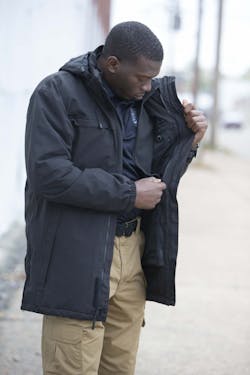Content provided by Propper International
As fall turns into winter, the temps drop and it’s time to think once again about layering up the jackets and sweaters. Don’t get caught out in the cold. You want to make sure you have the right gear to stay warm through those cold shifts and training exercises. At the same time, because you’re in law enforcement, you have more to think about than just fighting off the chill. You have to be able to fight suspects or an armed attacker and easily access the tools you need to win.
Unless you live in an area that is constantly warm in the winter, you’ll need cold weather gear that flexes with the rising and falling temperatures you experience in a lot of middle and northern latitude climates. This means you’ll need to dress in layers and keep those layers with you even on the best days.
Layers
We’ve all heard the advice “dress in layers” because it’s true. Start with a moisture-wicking base layer. While it may sound strange to wear a shirt that seems more suited to summer than winter, just because it’s cold doesn’t mean you won’t sweat. And when you do, all that sweat will get stuck right next to your skin and make you chilly if your shirt doesn’t wick it away, leaving you shivering. Base layers come in both long and short sleeve versions. And they don’t have to be a t-shirt, although that can be a good option. If you need a collared shirt, try a long or short sleeve moisture wicking polo.
This base layer also works as a great skin protector against concealed body armor rub. Need another reason to wear body armor beyond the obvious life-saving properties? It will keep you warmer in the winter.
For the next layer, you have some options depending on the temperature and other weather factors. If it’s sunny and clear or cloudy but not raining, a light fleece or even a sweater might work. No, not a cardigan like your grandfather used to wear as he read his newspaper by the fire, but a modern tech sweater that offers warmth and comfort with a professional polish.
If the skies open up, throw on a waterproof rain jacket with a good hood to stay dry and warm. Since storms can pop anytime, it’s good to be prepared with a packable waterproof jacket and pants you can keep in your car or everyday carry bag just in case.
When the dead of winter finally sets in, it’s time to throw on the last layer: a parka. Look for lightweight, but make sure it will really keep you warm. However, don’t worry about how warm it is by itself because you’ll likely be wearing other layers underneath.
If you want to be really efficient, a 3-in-1 system can provide all the outerwear layers you need in a self-contained jacket the includes a zip-out fleece or sweater-type liner inside a parka that repels water. The inside can be worn by itself in mild chill, the parka shell by itself on rainy days and the combined garment when the temps drop.
One part of the body that is often neglected in colder temps is the legs. Conventional thinking is “keep the core warm, the rest follows,” but that’s not always true for everyone. If you’re one whose legs get cold or you’re going to be outside for an extended period of time, consider throwing a mid-weight base layer under your tactical or duty pants to add that extra level of warmth and protection against the biting chill.
Thinking Tactically
Now that you’re all layered up, how do you reach your gear? Can you still draw your gun if needed? Or is it buried under so many layers that it’ll take until Tuesday afternoon to unearth it? That’s why many of the best tactical layering systems come with one feature you won’t find in department store apparel: tear-away sides and secret pass-throughs that give you quick access to a weapon. Many times the tear-aways can wrap around the belt side of your duty holster so you can access your weapon without moving anything aside.
Invest in LE-specific layers, designed for the job. Whatever climate you work in, be prepared to tackle the weather anytime, anywhere by layering up (and down) to suit, all the while assuring you have quick and easy access to essential gear.






